Facts About Superb lyrebird
The superb lyrebird, an enchanting songbird native to Australia, is celebrated for its stunning tail, intricate courtship displays, and extraordinary mimicry skills. Found primarily in the forests of southeast Australia, this bird was first described in 1800 by Major-General Thomas Davies. It belongs to the family Menuridae and is one of two species in the genus Menura, the other being Albert's lyrebird. The name "lyrebird" is derived from the Greek words for "moon" and "tail" inspired by the crescent-like patterns of their tail feathers.
These birds have a long history, with fossils dating back approximately 15 million years. Their range extends from southern Victoria to southeastern Queensland, with an introduced population thriving in southern Tasmania. They flourish in various forest environments but prefer wet forests and rainforests. The superb lyrebird is quite large, with males growing up to one meter in length and displaying ornate tail feathers.
Superb lyrebirds are primarily terrestrial and solitary. Males have territories that overlap with those of several females. Their diet mainly consists of invertebrates, such as earthworms and insects, which they forage for on the forest floor. During the breeding season, males construct mounds to perform their courtship displays, attracting females who then choose a mate. Females are responsible for all parental duties, from nest-building to raising the young.
One of the most remarkable traits of the superb lyrebird is its mimicry. Males can imitate a wide range of sounds, from other bird calls to man-made noises. Even females exhibit some mimicry skills. The quality of a male’s mimicry improves with age and is a key factor in attracting females, who prefer mates with the most accurate imitations.
The superb lyrebird also plays a crucial role in its ecosystem. Their foraging aids in nutrient cycling and can even reduce wildfire risks. However, they face threats from native predators, such as birds of prey, and human activities, including vehicle collisions and habitat disturbances. Despite these dangers, superb lyrebirds have developed strategies like mimicry and cautious behaviors to mitigate risks.
